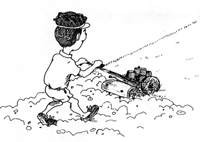Preparing to Renovate Over Bare Soil
Kill or Remove the Grass
Renovation on bare soil provides a golden opportunity to relieve compaction problems and fill in any uneven or sunken areas of the lawn that are problems. First, get rid of the existing grass. While you can scrape up the live sod to expose the bare soil, a significant portion of topsoil goes with it. The easiest way is kill all the existing grass and weeds in the lawn with a burndown herbicide such as KleenUpä that kills their roots too. It is "nonselective," which means it kills virtually any plant it is sprayed on.
About 10 days to two weeks prior to the scheduled lawn renovation, spray the herbicide over the turf area that is to be replaced. Choose a calm day to avoid damaging nearby plantings from spray drift. Use a compression sprayer that allows you to direct the spray close to the surface of the lawn.
Till Soil Organic Matter into Soil

After about 10 days, the lawn is dead so you can till the soil to get some air and organic matter into it before sowing grass seed. Use a large self-propelled gasoline powered tiller or a commercial riding tiller that can cut through the sod to loosen the soil down at least 6 inches. Rental agencies usually deliver and pick up this equipment for an additional fee.
Spread about 1 to 2 inches of Canadian sphagnum peat moss, composted municipal sludge, compost or other material rich in organic humus over the dead sod and then till it in. This is a good time to also add some slow acting granular lawn fertilizer or seed starting fertilizer to the soil. The tiller will break up the dead sod and soil clumps and mix in the organic topdressing and fertilizer to build a loose, rich topsoil for a seed bed. Do not overdo the tilling and risk destroying the soil structure. Overtilled soil has such fine particles that it compacts in a relatively short period of time.
After tilling, level and smooth the entire seedbed area with a garden rake. Remove any stones that have surfaced and fill in any indentations in the lawn area. Do not roll the soil. The pressure of foot traffic as you walk on newly tilled soil will firm it a bit, but avoid compacting it all over again.
Kill New Weeds
While it is tempting to sow grass seed immediately on the newly prepared seedbed of bare soil, there is another step to take first. The process of tilling invariably surfaces thousands of weed seeds that exist in the top six inches of soil throughout the world. Sowing grass seed without dealing with those weed seeds will result in new turf with 50% grass and 50% weeds.
Water the newly tilled bare soil to germinate all weed seeds on the surface of the soil. After about a week, a green fuzz of weed seedlings will be visible there. Spray them with the nonselective herbicide to kill them, roots and all. If you do not disturb the soil again, most weed problems are eliminated.
